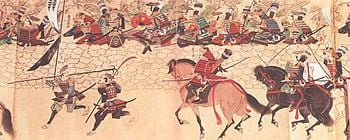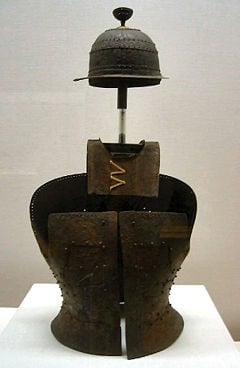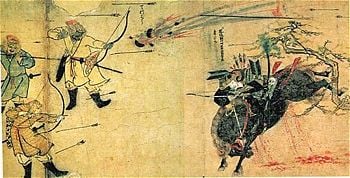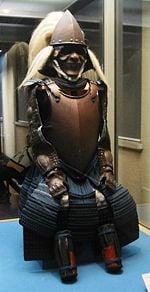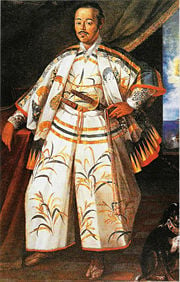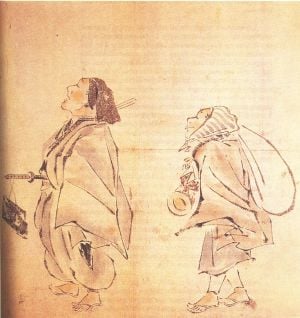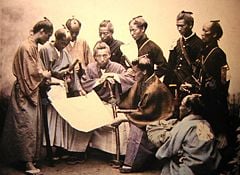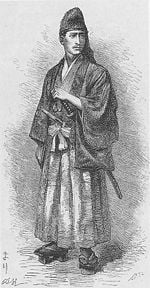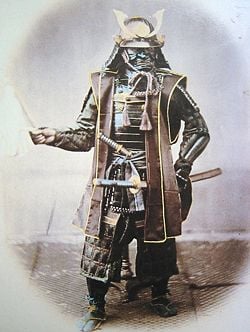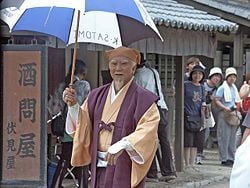Samurai
Samurai (侍 or, more rarely, 士) was a term for the military nobility in pre-industrial Japan who were active primarily between the tenth and nineteenth century. The word samurai is derived from the Japanese verb saburau, meaning “to serve”; a samurai is the retainer of a lord.
Samurai gradually developed Bushido (武士道), or the “Samurai code,” by integrating Confucian ethics and Zen Buddhism, which played an important role in developing Japanese ethical virtues and spiritual ethos. Almost all the key leaders of the Meiji Restoration were lower class samurai. The samurai is a heroic figure often featured in literature, film and television shows that are popular not only with Japanese but with Western audiences.
Overview
Originally warrior mercenaries in the employ of the emperor and noble clans (kuge, 公家), the samurai slowly gathered enough power to usurp the aristocracy and established the first samurai-dominated government after the Heiji Rebellion of 1160. The samurai gradually became a noble class, and developed a culture and tradition which strongly influenced the culture of Japan. After the eleventh century, samurai were expected to be cultured and literate. Social mobility allowed those who were heroic in battle to rise to samurai status until Toyotomi Hideyoshi, himself the son of a poor peasant family, became a grand minister in 1586 and created a law making the samurai caste permanent and heritable, and forbidding non-samurai to carry weapons. This effectively ended the social mobility of Japan until the dissolution of the Edo Shogunate by the Meiji revolutionaries in 1868.
During the thirteenth century, Zen Buddhism spread among samurai and helped to shape their standards of conduct. Shinto traditions and Confucian ethics also contributed to their code of conduct, which was formalized as the Bushido during the Edo period. Hagakure: The Book of the Samurai by Yamamoto Tsunetomo (c. 1706) is a manual of instruction which exemplified the behavior expected of an ideal samurai.
The military tactics of the samurai evolved with the development of new weapons. The arquebus, a matchlock gun introduced by the Portuguese in 1543 was quickly assimilated, and by the end of the feudal period, several hundred thousand firearms of superior workmanship existed in Japan. The katana (sword) which is synonymous with samurai did not become the primary weapon until the Edo period. It was usually paired with a dagger (wakizashi), and the katana and wakizashi together were called a daisho ("big and small").
During the Edo period (the Tokugawa era), after the general end of hostilities, samurai gradually lost their military function and became courtiers, bureaucrats, and administrators rather than warriors. They maintained a strict social hierarchy, marrying only other samurai, and developed cultural interests in scholarship, literature, art, poetry, tea and music.
The samurai class was dissolved during the Meiji Restoration, and many samurai families were impoverished. Many samurai used their education and training to enter into new professions and were gradually absorbed into the government bureaucracy and the middle class.
History
Origin
The origins of modern samurai are disputed, but it is believed that mounted warriors, archers, and foot-soldiers in the sixth century may have formed a proto-samurai. Following a disastrous military engagement with Tang China and the Silla dynasty in Korea, Japan underwent widespread reforms. One of the most important was the Taika Reform, an edict issued by Emperor Kōtoku in 646 C.E. which introduced Chinese cultural practices and administrative techniques throughout the Japanese aristocracy and bureaucracy. The later Taihō Code of 702 C.E. required the population to report regularly for a census, which was used as a precursor for national conscription. With an understanding of how the population was distributed, Emperor Mommu introduced a law drafting one of every three or four adult males into the national military. These soldiers were required to supply their own weapons, and in return were exempted from duties and taxes.
In the early Heian period, during the late eighth and early ninth centuries, Emperor Kammu (桓武天皇) sought to consolidate and expand his rule in northern Honshu, but the armies he sent to conquer the rebellious Emishi lacked motivation and discipline, and were unable to prevail. Emperor Kammu introduced the title of Seiitaishogun (征夷大将軍) or shogun, and began to rely on the powerful regional clans to conquer the Emishi. Skilled in mounted combat and archery (kyudo, 弓道), these clan warriors were used by the emperor to put down rebellions. Although these warriors may have been educated, at this time (seventh to ninth centuries C.E.) the Imperial court officials considered them to be little more than barbarians.
Emperor Kammu finally disbanded his army, and from this time the emperor's power gradually declined. While the emperor was still the ruler, powerful clans around Kyoto (京都) assumed positions as ministers, and their relatives bought positions as magistrates. To amass wealth and repay their debts, magistrates often imposed heavy taxes on the farmers, with the result that many of them lost their land. As the danger of robbery increased, the clans began recruiting these exiles in the Kanto plains. With their intense training in the martial arts, they proved to be effective guards. Small numbers of them would accompany tax collectors and could deter thieves and bandits from attacking, merely by their presence. They were saburai, armed retainers, yet the advantage which they held by being the sole bearers of arms quickly became apparent. Through protective agreements and political marriages, they accumulated political power, eventually surpassing the traditional aristocracy.
Some clans had been originally formed by farmers who had taken up arms to protect themselves from the imperial magistrates sent to govern their lands and collect taxes. These clans formed alliances to protect themselves against more powerful clans, and by the mid-Heian period they had adopted characteristic Japanese armor and weapons, and laid the foundations of Bushido, their ethical code.
After the eleventh century, samurai were expected to be cultured and literate, and they lived up to the ancient saying "Bun Bu Ryo Do" ("literary arts, military arts, both ways") or "The pen and the sword in accord." An early term for warrior, Uruwashii, was written with a Chinese character that combined the characters for literary study ("bun," 文) and military arts ("bu," 武), and is mentioned in the Heike Monogatari (late twelfth century). The Heike Monogatari refers to the ideal of an educated poet-swordsman in its mention of Taira no Tadanori's death:
Friends and foes alike wet their sleeves with tears and said, “What a pity! Tadanori was a great general, pre-eminent in the arts of both sword and poetry.”
According to William Scott Wilson in his book Ideals of the Samurai:
The warriors in the “Heike Monogatari” served as models for the educated warriors of later generations, and the ideals depicted by them were not assumed to be beyond reach. Rather, these ideals were vigorously pursued in the upper echelons of warrior society and recommended as the proper form of the Japanese man of arms. With the “Heike Monogatari,” the image of the Japanese warrior in literature came to its full maturity.
Wilson then translates the writings of several warriors who mention the “Heike Monogatari” as an example for their men to follow.
Kamakura Bakufu and the Rise of Samurai
Originally the warriors were merely mercenaries in the employ of the emperor and noble clans (kuge, 公家), but slowly they gathered enough power to usurp the aristocracy and establish the first samurai-dominated government.
As regional clans gathered manpower and resources and struck alliances with each other, they formed a hierarchy centered around a toryo (chief). This chief was typically a distant relative of the emperor, and a lesser member of one of three noble families (the Fujiwara, Minamoto, or the Taira). Originally sent to provincial areas for fixed four-year terms as magistrates, the toryo declined to return to the capital when their terms ended, and their sons inherited their positions and continued to lead the clans in putting down rebellions throughout Japan during the middle and later Heian period.
Because of their rising military and economic power, the clans gradually became a new force in the politics of the court. Their involvement in the Hōgen Rebellion in the late Heian period consolidated their power, and finally pitted the rival Minamoto and the Taira clans against each other, in the Heiji Rebellion of 1160. Emerging victorious, Taira no Kiyomori became an imperial advisor, the first warrior to attain such a position, and eventually seized control of the central government, establishing the first samurai-dominated government and relegating the emperor to figurehead status. However, the Taira clan was still very conservative in comparison with its eventual successor, the Minamoto. Instead of expanding or strengthening its military might, the Taira clan attempted to exercise control through the emperor by arranging marriages between its women and the emperors.
The Taira and the Minamoto clashed again in 1180, beginning the Genpei War which ended in 1185. The victorious Minamoto no Yoritomo established the superiority of the samurai over the aristocracy. In 1190 he visited Kyoto and in 1192 became Seii Taishogun, establishing the Kamakura Shogunate or Kamakura Bakufu. Instead of ruling from Kyoto, he set up the Shogunate in Kamakura, Kanagawa, near his base of power. Bakufu means “tent government,” taken from the encampments the soldiers would live in, in accordance with the Bakufu's status as a military government.
Over time, powerful samurai clans became warrior nobility (buke), who were only nominally under the court aristocracy. When the samurai began to adopt aristocratic pastimes like calligraphy, poetry and music, some court aristocrats in turn began to adopt samurai customs. In spite of various machinations and brief periods of rule by various emperors, real power was now in the hands of the shogun and the samurai.
Ashikaga Shogunate and the Feudal Period
In 1274, the Yuan Dynasty (Mongol Empire) sent a force of some 40,000 men and nine hundred ships to invade northern Kyushu in Japan. Japan mustered a mere ten thousand Samurai to meet this threat. The invading army was harassed by major thunderstorms throughout the invasion, which aided the defenders by inflicting heavy casualties. The Yuan army was eventually recalled and the invasion called off. The Mongol invaders used small, exploding bombs, probably the first appearance of bombs and gunpowder in Japan.
The Japanese defenders recognized the possibility of a renewed invasion, and began construction of a great stone barrier around Hakata Bay in 1276. Completed in 1277, this wall stretched for 20 kilometers around the border of the bay. This would later serve as a strong defensive point against the Mongols. The Mongols attempted to settle matters in a diplomatic way from 1275 to 1279. Each envoy that was sent to Japan was executed, and this time set the stage for one of the most famous engagements in Japanese history.
In 1281, a Yuan army of 140,000 men with 4,400 ships was mustered for a renewed invasion of Japan. Northern Kyushu was defended by a Japanese army of 40,000 men. The Mongol army was still on its ships preparing for the landing operation when a typhoon hit north Kyushu Island. The casualties and damage inflicted by the typhoon, followed by the Japanese defense of the Hakata Bay barrier, resulted in the Mongols again recalling their armies.
The thunderstorms of 1274 and the typhoon of 1281 helped the samurai defenders of Japan repel the Mongol invaders despite their being vastly outnumbered. These winds became known as kami-no-kaze, which literally translates as "wind of the gods." This is often given a simplified translation as "divine wind." The kami-no-kaze lent credence to the Japanese belief that their lands were indeed divine and under supernatural protection.
In the fourteenth century, a blacksmith called Masamune developed a two-layer structure of soft and hard steel for use in swords. This structure gave swords much-improved cutting performance and endurance, and the production technique led to Japanese swords (katana) being recognized as some of the most potent hand weapons of pre-industrial East Asia. Many swords made using this technique were exported across the East China Sea, a few making their way as far as India.
As primogeniture replaced the division of succession which had been defined by law before the fourteenth century, issues of inheritance caused family infighting. To resolve infighting, it was common for samurai to invade neighboring territories, and bickering among samurai was a constant problem for the Kamakura and Ashikaga Shogunates.
The Sengoku jidai ("warring-states period") was marked by the loosening of samurai hierarchy; people born into other social strata sometimes made names for themselves as warriors and became de facto samurai. During this turbulent period, bushido ethics became important in maintaining public order.
Japanese war tactics and technologies improved rapidly during the fifteenth and sixteenth centuries. The use of large numbers of infantry called ashigaru ("light-foot," for their light armor), formed of humble warriors or ordinary people with nagayari (long spears) or naginata (long swords), was introduced and combined with cavalry in maneuvers. The numbers of people mobilized in warfare ranged from thousands to hundreds of thousands. Ninja also played critical roles in intelligence activity.
The arquebus, a matchlock gun, was introduced by the Portuguese via a Chinese pirate ship in 1543, and the Japanese succeeded in assimilating it within a decade. Groups of mercenaries with mass-produced arquebuses played a critical role in battles. By the end of feudal period, several hundred thousand firearms existed in Japan and massive armies numbering over 100,000 clashed in battles. By comparison, the largest and most powerful army in Europe, the Spanish, had only several thousand firearms and could only assemble 30,000 troops.
In 1592, and again in 1598, Toyotomi Hideyoshi decided to invade China (唐入り) and sent an army of 160,000 samurai to Korea. Hideyoshi's invasions of Korea, 朝鮮征伐, used Japanese mastery of the arquebus to great advantage over Korea's poorly organized army. The most famous samurai in this war were Kato Kiyomasa and Shimazu Yoshihiro.
Social mobility increased as the ancient regime collapsed and emerging samurai needed to maintain large military and administrative organizations in their areas of influence. Most of the samurai families that survived until the nineteenth century originated during this era, declaring themselves to be from the lineage of one of the four ancient noble clans, Minamoto, Taira, Fujiwara and Tachibana.
Oda, Toyotomi and Tokugawa
Oda Nobunaga was the well-known lord of the Nagoya, Aichi area (once called Owari Province) and an exceptional example of the samurai of the Sengoku Period. He laid down the path for his successors to achieve the reunification of Japan under a new bakufu (shogunate) a few years after his death.
Oda Nobunaga made advances in the fields of military organization and war tactics, used arquebuses extensively, developed commerce and industry, and promoted innovations. Consecutive victories enabled him to accomplish the dissolution of the Ashikaga Bakufu and the disarmament of the military organizations of the Buddhist monks, which had inflamed futile struggles among the populace for centuries. Attacking from a "sanctuary" of Buddhist temples, they had been a constant headache to the warlords and even to the emperor, who tried to control their actions. Oda Nobunaga died in 1582 when one of his generals, Akechi Mitsuhide, turned upon him with his army.
Toyotomi Hideyoshi and Tokugawa Ieyasu, who founded the Tokugawa Shogunate, were loyal followers of Nobunaga. Hideyoshi was a nameless peasant who was raised up to be one of Nobunaga's top generals, and Ieyasu had shared his childhood with Nobunaga. Hideyoshi defeated Mitsuhide within a month and was accepted as the rightful successor of Nobunaga by avenging the treachery of Mitsuhide.
Hideyoshi and Tokugawa inherited Nobunaga's previous achievements as a foundation on which build a unified Japan. There was a saying: "The reunification is a rice cake; Oda made it. Hashiba shaped it. At last, only Ieyasu tastes it" (Hashiba is the family name that Toyotomi Hideyoshi used while he was a follower of Nobunaga).
Toyotomi Hideyoshi, who became a grand minister in 1586 and was himself the son of a poor peasant family, created a law making the samurai caste permanent and heritable, and forbidding non-samurai to carry weapons, thereby ending the social mobility of Japan until the dissolution of the Edo Shogunate by the Meiji revolutionaries in 1868.
It is important to note that the distinction between samurai and non-samurai was so obscure that during the sixteenth century, most male adults in any social class (even small farmers) belonged to at least one military organization of their own and served in wars before and during Hideyoshi's rule.
The authorized samurai families after the seventeenth century were those that chose to follow Nobunaga, Hideyoshi and Ieyasu. Large battles took place during the change of regimes, and a number of defeated samurai were destroyed, became ronin (disaffected samurai), or were absorbed into the general populace.
Tokugawa Shogunate
With no major battles after the early seventeenth century, samurai gradually lost their military function during the Tokugawa era (Edo period) and became courtiers, bureaucrats, and administrators rather than warriors.
By the end of the Tokugawa era, samurai were aristocratic bureaucrats for the daimyo, with their daisho, the paired long and short swords of the samurai (katana and wakizashi) becoming a symbolic emblem of power rather than a weapon used in daily life. They still had the legal right to cut down any commoner who did not show proper respect, but to what extent this right was used is unknown. When the central government forced daimyos to cut the size of their armies, unemployed ronin (disaffected samurai) became a social problem.
Theoretical obligations between a samurai and his lord (usually a daimyo) increased from the Genpei era to the Edo era. They were strongly emphasized by the teachings of Confucius and Mencius (c. 550 B.C.E.), which were required reading for the educated samurai class. During the Edo period, after the general end of hostilities, the code of Bushido was formalized. It is important to note that Bushido was an ideal, but that it remained uniform from the thirteenth century to the nineteenth century; the ideals of Bushido transcended social class, time and geographic location.
Bushido was formalized by samurai in this time of peace in much the same fashion as chivalry was formalized after knights as a warrior class became obsolete in Europe. The samurai code became a favorable model of conduct for citizens of Edo, emphasizing protocols and formalities. With time on their hands, samurai pursued new interests such as becoming scholars, artists and poets. Bushido still survives in present-day Japanese society, as do many other aspects of the samurai's way of life.
Decline During the Meiji Restoration
The samurai system quickly became obsolete after 1853, when United States Navy Commodore Matthew C. Perry’s massive steamships arrived and forced Japan to open her ports to foreign trade. Prior to that only a few harbor towns, under strict control of the shogunate, had been allowed to participate in trade with the West. Japanese leaders, faced with the threat of being invaded and colonized by foreign powers, recognized that they must modernize their government immediately.
The last showing of the original samurai was in 1867, when samurai from Choshu and Satsuma provinces defeated the Shogunate forces in favor of the rule of the emperor. These two provinces were the lands of the daimyo that had submitted to Ieyasu after the Battle of Sekigahara (1600). Other historians claim that the last samurai conflict was in 1877, during the Satsuma Rebellion at the Battle of Shiroyama. This conflict, led by Saigo Takamori, was a response to the radical changes instituted by the newly formed government, aimed at reducing the power of the feudal domains, including Satsuma, and the dissolution of samurai status.
Emperor Meiji abolished the samurai right to be the sole bearers of arms in favor of a more modern, western-style, conscripted army. Samurai became Shizoku (士族), retaining a portion of their salaries, but the right to wear a katana in public was eventually abolished, along with the right to cut down commoners who paid them disrespect. The status of samurai finally came to an end after hundreds of years. However, the rule of the state by the military class was not yet over.
Post-Meiji Restoration
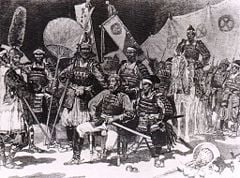
In defining the political structure of a modern Japan, members of the Meiji government decided to follow the United Kingdom and Germany, basing their system on a concept of "noblesse oblige" much like that of Prussia, in which the samurai would not be a political force.
When the Meiji reforms in the late nineteenth century abolished the samurai class, samurai families lost their income and their social status and were forced to seek new professions. Some samurai volunteered to be soldiers in the new western-style Imperial Japanese Army, and advanced to be trained as officers. Many of the officers of the Imperial Army were of samurai origin, highly motivated, disciplined and exceptionally well-trained.
Many early Japanese foreign exchange students were also samurai, because they were literate and well-educated scholars. Some of these exchange students founded private schools of higher education, while other samurai took up pens instead of guns and became reporters and writers, setting up newspaper companies. A large number of educated samurai entered government service.
Western Samurais
The English sailor and adventurer William Adams (1564-1620) helped the Japanese to build European-style ships and seems to have been the first foreigner to receive the status of samurai. The Shogun Tokugawa Ieyasu presented him with two swords representing the authority of a samurai, and decreed that William Adams the pilot was dead and that Miura Anjin (三浦按針), a samurai, was born. Adams also received the title of hatamoto (“bannerman”), a highly prestigious position as a direct retainer in the Shogun's court. He was provided with generous revenues: "For the services that I have done and do daily, being employed in the emperor's service, the emperor has given me a living." He was granted a fief in Hemi (逸見) within the boundaries of present-day Yokosuka City, "with eighty or ninety husbandmen, that be my slaves or servants." His estate was valued at 250 koku (measure of the income of the land in rice, equal to about five bushels). He finally wrote "God hath provided for me after my great misery" by which he meant the disaster ridden voyage that had initially brought him to Japan.
During the Boshin War (1868-1869), French soldiers joined the forces of the shogun against the southern daimyos favorable to the restoration of the Meiji emperor. It is recorded that the French Navy officer Eugène Collache fought in samurai attire, side-by-side with his Japanese brothers-in-arms.
Culture
As an aristocratic class for centuries, the samurai developed their own culture, a culture that became an integral part of Japanese culture.
Education
A samurai was expected to read and write, as well as to know some mathematics. Toyotomi Hideyoshi, who was born a peasant but rose to become a great samurai, could only read and write in hiragana; this was a significant drawback for him. Samurai were expected, though not required, to have interests in other arts such as dancing, Go, literature, poetry, and tea. Ōta Dōkan, the first ruler of Edo, wrote that he was shamed when he realize that even a commoner had more knowledge of poetry than he had, and abdicated because of this.
Names
A samurai was usually named by combining one kanji (Chinese character) from his father or grandfather’s name and one new kanji. Samurai normally used only a small part of their total name.
For example, the full name of Oda Nobunaga was "Oda Kazusanosuke Saburo Nobunaga" (織田上総介三郎信長), in which "Oda" was a clan or family name; "Kazusanosuke" was a title of vice-governor of Kazusa province; "Saburo" was a name before genpuku, a coming-of-age ceremony; and "Nobunaga" was an adult name.
Marriage
The marriage of samurai was arranged by someone with the same or higher rank than those being married. For samurai of the upper ranks this was a necessity, as most had few opportunities to meet a female, but for lower-ranked samurai it was only a formality. Most samurai married women from a samurai family, but lower-ranked samurai were permitted to marry commoners. In these marriages a dowry was brought by the woman and was used to start the couple’s new life together.
A samurai could have a mistress, but her background was strictly reviewed by higher-ranked samurai. In many cases, this relationship was treated like a marriage. When a samurai wished to marry a commoner, a messenger would be sent, with betrothal money or a note granting an exemption from taxes, to ask for her parent's acceptance, and many parents gladly accepted. If a samurai's wife gave birth to a son he could be a samurai. In order to advance their social status, some rich merchants had their daughters marry samurai in exchange for erasing the samurai’s debt.
A samurai could divorce his wife for a variety of reasons with approval from a superior, but divorce was rare. One reason for divorce might be if the wife did not produce a son, but adoption could be arranged as an alternative to divorce. A samurai could divorce for personal reasons, even if he simply did not like his wife, but this was generally avoided as it would embarrass the samurai who had arranged the marriage. A woman could also arrange a divorce, although it would generally take the form of the samurai divorcing her. After a divorce, samurai were required to return the dowry, which served as a deterrent.
A samurai's wife would be dishonored and allowed to commit jigai (female seppuku) if she were cast off.
Philosophy
The philosophies of Buddhism and Zen, as well as Shinto, and to a lesser extent, Confucianism, influenced the samurai culture. Zen meditation became an important teaching because it offered a means of calming one's mind in the face of danger. The Buddhist concept of reincarnation and rebirth led samurai to abandon torture and needless killing, and some samurai even gave up violence altogether and became Buddhist monks after realizing the fruitlessness of war. There are reports of samurai who allowed themselves to be killed on the battlefield as they came to terms with these realizations. Confucianism influenced samurai philosophy by stressing the importance of the relationship, characterized by loyalty, between a retainer and his lord.
Bushido was a term associated with the samurai "code of conduct" enforced during the Edo period by the Tokugawa Shogunate as a means of controlling the samurai more effectively. The deceptive simplicity of bushido led to countless arguments over its interpretation. Hagakure: The Book of the Samurai by Yamamoto Tsunetomo is a manual of instruction in the way of the samurai. Even as it was published, it received a number of reviews that criticized its strict and impersonal approach to ethics. If a lord mistakenly ordered a massacre of civilians, should the samurai observe loyalty and massacre innocent people as his lord commanded, or should he observe rectitude and let the civilians escape unharmed? If a man, whose parents were elderly and ill, committed an unforgivable mistake, should he protect his honor by committing seppuku, or should he display courage by living with dishonor in order to care for his aged parents?
The incident of the 47 ronin, in which a group of samurai avenged the dishonor of their master, who had been forced to commit seppuku (ritual suicide) for assaulting a court official, by killing the official and being themselves forced to commit seppuku, caused endless debates about the righteousness of the samurais' actions and how bushido should be applied. They had defied the shogun by taking matters into their own hands and killing the court official, but it was an act of rectitude and loyalty to their master. Finally, their action was judged to exhibit rectitude, but disloyalty to the shogun. This made them criminals with conscience and eligible for seppuku. The story became a national legend and was thought to represent the attitude which all good people should display in their lives.
Samurai Women
The main duty of samurai women was to maintain the household, or ie. This was especially crucial during the early feudal ages, when warrior husbands were often traveling abroad or engaged in clan battles. The wife, or okusan (one who remains in the home), was left to manage all household affairs, care for the children, and perhaps even forcibly defend the home. For this reason, many women of the samurai class were trained in wielding a polearm called a naginata, which they could use to protect their household, family, and honor if the need arose.
Traits valued in women of the samurai class were humility, obedience, self-control, strength, and loyalty. Ideally, a samurai wife would be skilled at managing property, keeping records, dealing with financial matters, educating the children (and perhaps servants), and caring for elderly parents or in-laws who might be living under her roof. Confucian law, which helped define personal relationships and the code of ethics of the warrior class, required that a woman show subservience to her husband, filial piety to her parents, and dedication towards the children. A woman was also expected to exercise discipline, since too much love and affection was said to indulge and spoil the youngsters.
Though women of wealthier samurai families enjoyed the benefits of their elevated position in society, such as avoiding the physical labor often engaged in by women of the lower classes, they were still considered to be far beneath men. Women were prohibited from engaging in any political affairs and were usually not the heads of their households.
As the Tokugawa period progressed, more value was placed on education, and the education of females beginning at an early age became important to families and society as a whole. The criteria for eligibility as a candidate for marriage included intelligence and education as well as physical attractiveness and social status. Though many of the texts written for women during the Tokugawa period only concerned how a woman could become a successful wife and household manager, some undertook the challenge of learning to read Chinese, and tackled philosophical and literary classics. By the end of the Tokugawa period nearly all female samurai were literate.
Weapons
The katana is the weapon that is synonymous with samurai. Bushido taught that a samurai's soul was his katana, and sometimes a samurai was pictured as entirely dependent on the katana when fighting. However, the use of swords did not become common in battle until the Kamakura period (1185-1333), where the tachi and uchigatana (the direct predecessor to the katana) became prevalent. The katana itself did not become the primary weapon until the Edo period.
After a male child of the bushi was born, he would receive his first sword in a ceremony called mamori-gatana. The sword, however, was merely a charm sword covered with brocade to which was attached a purse or wallet, worn by children under five. Upon reaching the age of thirteen, in a ceremony called Genbuku (元服), a male child became a samurai and was given his first real swords and armour and an adult name.
A katana and a wakizashi together are called a daisho ("big and small"). The wakizashi was a samurai's "honor blade" and never left the samurai's side. He would sleep with it under his pillow and it would be taken with him when he entered a house and had to leave his main weapons outside. The tanto was a small dagger sometimes worn with the wakizashi in a daisho. The tanto or the wakizashi was used to commit seppuku.
The samurai stressed skill with the yumi (longbow), reflected in the art of kyudo (“the way of the bow”). The bow remained a critical component of the Japanese military even after the introduction of firearms during the Sengoku Jidai period. The yumi, an asymmetric composite bow made from bamboo, wood, and leather, was not as powerful as the Eurasian reflex composite bow, having an effective range of 50 meters or less (100 meters with less accuracy). It was usually used on foot from behind a tedate (手盾), a large and mobile bamboo wall, but shorter versions (hankyu) could also be used from horseback. The practice of shooting from horseback became the Shinto ceremony of Yabusame (流鏑馬).
In the fifteenth century, the yari (spear) also became a popular weapon, displacing the katana along with the naginata from the battlefield as personal bravery became less important and battles were organized around massed, inexpensive foot troops. A charge, mounted or dismounted, was more effective when using a spear than a katana, and it offered better than even odds against a samurai using a katana. In the Battle of Shizugatake where Shibata Katsuie was defeated by Toyotomi Hideyoshi, then known as Hashiba Hideyoshi, the Seven Spearmen of Shizugatake (賤ヶ岳七本槍) played a crucial role in the victory.
During the latter half of the sixteenth century, Portuguese trade introduced the arquebus in Japan, enabling warlords to raise effective armies from masses of peasants. The new weapons were highly controversial. Their ease of use and deadly effectiveness was perceived by many as a dishonorable affront to Bushido tradition. Oda Nobunaga made deadly use of the arquebus at the Battle of Nagashino in 1575, leading to the demise of the Takeda clan. After their initial introduction by the Portuguese and the Dutch, the matchlock arquebus, or teppo, were produced on a large scale by Japanese gunsmiths. By the end of the sixteenth century, there were more firearms in Japan, of superior craftsmanship, than in any European nation. Teppo, employed en masse largely by ashigaru (peasant foot troops) were in many ways the antithesis of samurai valor.
With the establishment of the Tokugawa shogunate and an end to civil war, production of the guns declined sharply and their ownership was restricted. By the Tokugawa Shogunate most spear-based weapons had been phased out, partly because they were less effective for the close-quarter combat common in the Edo period. The daisho (katana and wakizashi) became the only weapons typically carried by samurai.
Some other weapons used by samurai were jo, bo, grenade, Chinese trebuchets (more as an anti-personnel weapon than a siege engine) and cannon (infrequently and at great expense).
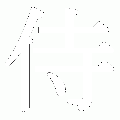
The term samurai originally meant "those who serve in close attendance to nobility," and was written in the Chinese character (kanji) that had the same meaning. In Japanese, it was originally pronounced in the pre-Heian period as saburapi and later as saburai, then samurai in the Edo period. In Japanese literature, there is an early reference to samurai in the Kokinshu (古今集, early tenth century):
- Attendant to your nobility
- Ask for your master's umbrella
- The dews 'neath the trees of Miyagino
- Are thicker than rain (poem 1091)
The word bushi (武士, "warrior" or "armsman") first appears in an early history of Japan called Shoku Nihongi (続日本記, 797 C.E.) In a portion of the book covering the year 723 C.E., Shoku Nihongi states: "Literary men and Warriors are they whom the nation values." The term bushi is of Chinese origin and adds to the indigenous Japanese words for "warrior": tsuwamono and mononofu. The terms bushi and samurai became synonymous near the end of the twelfth century, according to William Scott Wilson in his book Ideals of the Samurai—Writings of Japanese Warriors. Wilson states that Bushi actually translates as "a man who has the ability to keep the peace, either by literary or military means, but predominantly by the latter."
It was not until the early modern period, the Azuchi-Momoyama period and early Edo period of the late sixteenth and early seventeenth centuries that the word saburai was replaced with samurai.
During the era of the rule of the samurai, the term yumitori (弓取, "bowman") was also used as an honorary title of an accomplished warrior even though swordsmanship had become more important (Japanese archery, kyujutsu, is still strongly associated with the war god Hachiman).
A samurai with no attachment to a clan or daimyo (大名) was called a ronin (浪人). In Japanese, the word ronin means "wave man," a person destined to wander aimlessly forever, like the waves in the sea. The word came to mean a samurai who was no longer in the service of a lord because his lord had died, because the samurai had been banished or simply because the samurai had chosen to become a ronin.
The pay of samurai was measured in koku of rice (180 liters; enough to feed a man for one year). Samurai in the service of the han (feudal domain) were called hanshi.
The following terms are related to samurai or the samurai tradition:
- Uruwashii
a cultured warrior symbolized by the kanji for "bun" (literary study) and "bu" (military study or arts) - Buke (武家)
A martial house or a member of such a house - Mononofu (もののふ)
An ancient term meaning a warrior. - Musha (武者)
A shortened form of Bugeisha (武芸者, “martial art man”). - Shi (士)
A word roughly meaning "gentleman," it is sometimes used for samurai, in particular in words such as bushi (武士, “warrior” or samurai). - Tsuwamono (兵)
An old term for a soldier popularized by Matsuo Basho in his famous haiku. Literally “strong person.”
| natsukusa ya tsuwamono domo ga yume no ato Matsuo Basho | Summer grasses, All that remains Of soldiers’ dreams (trans. Lucien Stryk) |
Myth and Reality
Most samurai (during the Edo period) were bound by Bushido (武士道), a strict code of honor which allowed a disgraced samurai to regain his honor by passing into death, where samurai were still beholden to the rules of Bushido. The Bushido code was written in peace-time and may not have truly reflected the samurai's character as a warrior. There are many romanticized characterizations of samurai behavior, but studies of Kobudo and traditional Budo indicate that the samurai were as practical on the battlefield as any other warrior.
Despite the Bushido, in practice, samurai could be disloyal and treacherous (Akechi Mitsuhide), cowardly, brave, or overly loyal (Kusunoki Masashige). Samurai were usually loyal to their immediate superiors, who in turn allied themselves with higher lords. These loyalties to the higher lords often shifted; for example, the high lords allied under Toyotomi Hideyoshi (豊臣秀吉) were served by loyal samurai, but the feudal lords under them could shift their support to the Tokugawa clan, taking their samurai with them. There were, however, also notable instances where samurai would be disloyal to their lord or daimyo, when loyalty to the emperor was seen to have supremacy.
A legendary ability was the Duel of Wills, a psychological technique to test an enemy's mental strength without engaging in actual fighting. Both combatants (who must be, as samurai, of equal status) locked eyes and remained staring at each other in silence and without moving a muscle, until one of the opponents yielded (there are stories of rare instances in which both opponents relented simultaneously).
Popular culture
Jidaigeki (historical drama) has always been a staple on Japanese television and in movies. The stories typically feature a samurai with a kenjutsu who stood up against evil samurai and merchants. Mito Komon (水戸黄門), a fictitious series of stories about Tokugawa Mitsukuni's travels, is a popular TV drama in which Mitsukuni, a brother of the emperor, travels disguised as a retired rich merchant with two unarmed samurai disguised as his companions. He finds trouble wherever he goes, and after gathering evidence, has his samurai punish evil samurai and merchants, before revealing his identity.
The samurai-themed works of film director Akira Kurosawa have influenced many filmmakers across the world with their technique and storytelling. His notable works include The Seven Samurai, in which a besieged farming village hires a collection of wandering samurai to defend them from bandits; Yojimbo, about a former samurai who involves himself in a town's gang war by working for both sides; and The Hidden Fortress, in which two foolish peasants find themselves helping a legendary general escort a princess to safety. The latter was one of the primary inspirations for George Lucas's Star Wars, which also borrows a number of aspects from the samurai.
Samurai films and westerns share a number of similarities and the two genres have influenced each other over the years. Kurosawa was inspired by the works of director John Ford, and in turn Kurosawa's works were remade into westerns such as The Magnificent Seven (The Seven Samurai) and into A Fistful of Dollars (Yojimbo). There is also an anime adaptation of The Seven Samurai, Samurai 7, which spans many episodes.
Another fictitious television series, Abarembo Shogun, featured Yoshimune, the eighth Tokugawa shogun. Samurai at all levels from the shogun down to the lowest rank, as well as ronin, featured prominently in this show.
Shōgun is the first novel in James Clavell's Asian Saga. It is set in feudal Japan around the year 1600 and gives a highly fictionalized account of the rise of Tokugawa Ieyasu to the Shogunate, seen through the eyes of an English sailor whose fictional heroics are loosely based on William Adams' exploits.
A Hollywood movie, The Last Samurai, a mixture of fact and fiction, was released in 2003 in North America. The film's plot is loosely based on the 1877 Satsuma Rebellion led by Saigo Takamori, and also on the story of Eugène Collache, the French army captain who fought alongside Enomoto Takeaki in the Boshin War. The life-style and the war tactics shown in the movie The Last Samurai are those of rural samurai of the "Sengoku period” before 1543, not those in the 19th century. An actual battle of that period was only slightly different from those of European armies; a key difference was the waving of a katana instead of a saber to signal soldiers to charge.
The movie Ghost Dog: The Way of the Samurai, starring actor Forest Whitaker, takes as its central character a black assassin in contemporary America who gains inspiration from the Hagakure. The soundtrack album positions hip-hop against readings of the Hagakure.
The samurai have also appeared frequently in Japanese comics (manga) and animation (anime). Most common are historical works where the protagonist is either a samurai or former samurai who possesses considerable martial skill. Two of the most famous examples are Lone Wolf and Cub, where the former proxy executioner for the Shogun and his toddler son become hired killers after being betrayed by other samurai and nobles, and Rurouni Kenshin, in which a former assassin, after helping end the Bakumatsu era and bring about the Meiji era, finds himself protecting newfound friends and fighting off old enemies while upholding his oath to never kill again, through the use of a reverse-bladed sword.
See also
ReferencesISBN links support NWE through referral fees
- Daidoji, Yuzan, Oscar Ratti (illustrator), Thomas Cleary. The Code of the Samurai: A Modern Translation of the Bushido Shoshinshu of Taira Shigesuke. Tuttle Publishing, new edition, 1999. ISBN 0804831904
- Kure, Mitsuo. Samurai: An Illustrated History. Tuttle Publishing, 2002. ISBN 0804832870
- Turnbull, Stephen. Samurai: The World of the Warrior. Osprey Publishing, 2006. ISBN 1841769517
- Wilson, William Scott (ed.). Ideals of the Samurai: Writings of Japanese Warriors (History & Philosophy Series). Ohara Publications, 1982. ISBN 0897500814
- Yamamoto, Tsunetomo, and William Scott Wilson. Hagakure: The Book of the Samurai. Kodansha International, 2002. ISBN 4770029160
- Yuzan, Daidoji, Gary Miller Haskins (illustrator), and William Scott Wilson (trans.). Budoshoshinshu: The Warrior's Primer (Literary Links to the Orient). Ohara Publications, 1984. ISBN 0897500962
External links
All links retrieved December 22, 2022.
- SengokuDaimyo.com – The website of samurai author and historian Anthony J. Bryant
- The Samurai Archives
Credits
New World Encyclopedia writers and editors rewrote and completed the Wikipedia article in accordance with New World Encyclopedia standards. This article abides by terms of the Creative Commons CC-by-sa 3.0 License (CC-by-sa), which may be used and disseminated with proper attribution. Credit is due under the terms of this license that can reference both the New World Encyclopedia contributors and the selfless volunteer contributors of the Wikimedia Foundation. To cite this article click here for a list of acceptable citing formats.The history of earlier contributions by wikipedians is accessible to researchers here:
The history of this article since it was imported to New World Encyclopedia:
Note: Some restrictions may apply to use of individual images which are separately licensed.
